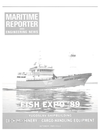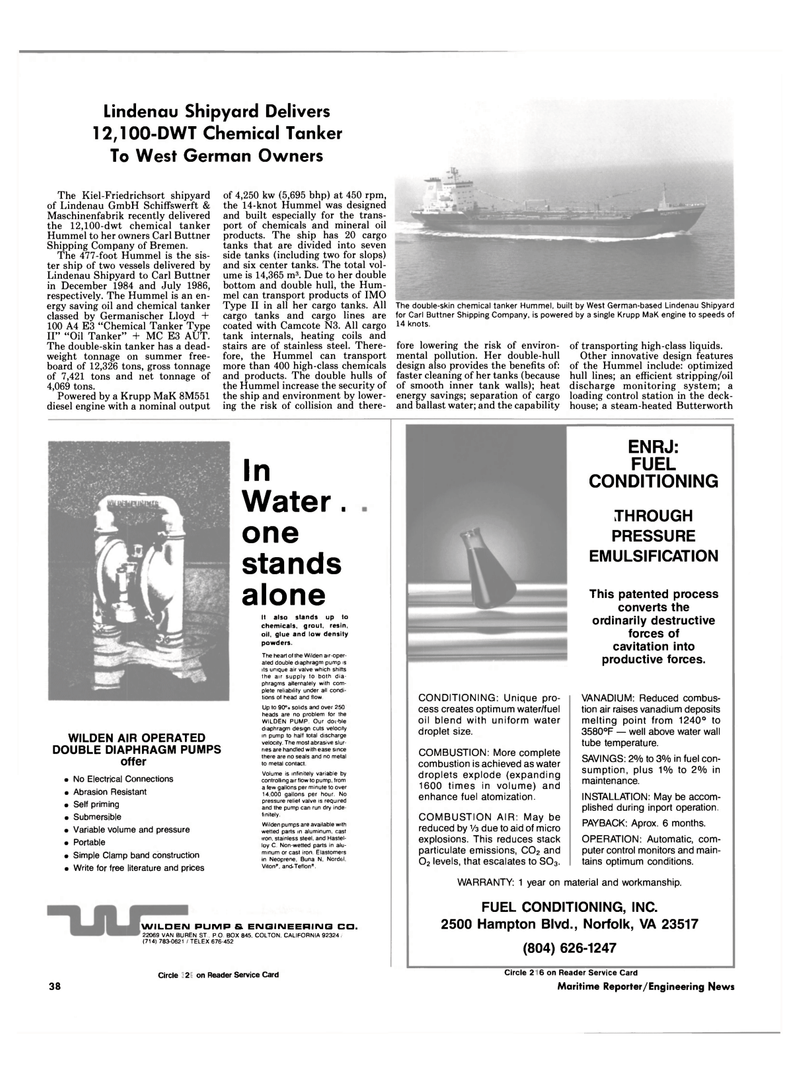
Page 38: of Maritime Reporter Magazine (October 1989)
Read this page in Pdf, Flash or Html5 edition of October 1989 Maritime Reporter Magazine
Lindenau Shipyard Delivers 12,100-DWT Chemical Tanker
To West German Owners
The Kiel-Friedrichsort shipyard of Lindenau GmbH Schiffswerft &
Maschinenfabrik recently delivered the 12,100-dwt chemical tanker
Hummel to her owners Carl Buttner
Shipping Company of Bremen.
The 477-foot Hummel is the sis- ter ship of two vessels delivered by
Lindenau Shipyard to Carl Buttner in December 1984 and July 1986, respectively. The Hummel is an en- ergy saving oil and chemical tanker classed by Germanischer Lloyd + 100 A4 E3 "Chemical Tanker Type
II" "Oil Tanker" + MC E3 AUT.
The double-skin tanker has a dead- weight tonnage on summer free- board of 12,326 tons, gross tonnage of 7,421 tons and net tonnage of 4,069 tons.
Powered by a Krupp MaK 8M551 diesel engine with a nominal output of 4,250 kw (5,695 bhp) at 450 rpm, the 14-knot Hummel was designed and built especially for the trans- port of chemicals and mineral oil products. The ship has 20 cargo tanks that are divided into seven side tanks (including two for slops) and six center tanks. The total vol- ume is 14,365 m3. Due to her double bottom and double hull, the Hum- mel can transport products of IMO
Type II in all her cargo tanks. All cargo tanks and cargo lines are coated with Camcote N3. All cargo tank internals, heating coils and stairs are of stainless steel. There- fore, the Hummel can transport more than 400 high-class chemicals and products. The double hulls of the Hummel increase the security of the ship and environment by lower- ing the risk of collision and there-
The double-skin chemical tanker Hummel, built by West German-based Lindenau Shipyard for Carl Buttner Shipping Company, is powered by a single Krupp MaK engine to speeds of 14 knots. fore lowering the risk of environ- mental pollution. Her double-hull design also provides the benefits of: faster cleaning of her tanks (because of smooth inner tank walls); heat energy savings; separation of cargo and ballast water; and the capability of transporting high-class liquids.
Other innovative design features of the Hummel include: optimized hull lines; an efficient stripping/oil discharge monitoring system; a loading control station in the deck- house; a steam-heated Butterworth
WILDEN AIR OPERATED
DOUBLE DIAPHRAGM PUMPS offer • No Electrical Connections • Abrasion Resistant • Self priming • Submersible • Variable volume and pressure • Portable • Simple Clamp band construction • Write for free literature and prices
In
Water. one stands alone
It also stands up to chemicals, grout, resin, oil, glue and low density powders.
The heart of the Wilden air-oper- ated double diaphragm pump is its unique air valve which shifts the air supply to both dia- phragms alternately with com- plete reliability under all condi- tions of head and flow.
Up to 90% solids and over 250 heads are no problem for the
WILDEN PUMP Our double diaphragm design cuts velocity in pump to half total discharge velocity. The most abrasive slur- ries are handled with ease since there are no seals and no metal to metal contact.
Volume is infinitely variable by controlling air flow to pump, from a few gallons per minute to over 14,000 gallons per hour. No pressure relief valve is required and the pump can run dry inde- finitely.
Wilden pumps are available with wetted parts in aluminum, cast iron, stainless steel, and Hastel- loy C. Non-wetted parts in alu- minum or cast iron. Elastomers in Neoprene, Buna N, Nordel,
Viton®, and-Teflon®.
WILDEINI PUMP Sl ENGINEERING CO. 22069 VAN BUREN ST., P.O. BOX 845, COLTON. CALIFORNIA 92324 / (714) 783-0621 / TELEX 676-452
CONDITIONING: Unique pro- cess creates optimum water/fuel oil blend with uniform water droplet size.
COMBUSTION: More complete combustion is achieved as water droplets explode (expanding 1600 times in volume) and enhance fuel atomization.
COMBUSTION AIR: May be reduced by Vz due to aid of micro explosions. This reduces stack particulate emissions, C02 and 02 levels, that escalates to S03.
ENRJ:
FUEL
CONDITIONING
THROUGH
PRESSURE
EMULSIFICATION
This patented process converts the ordinarily destructive forces of cavitation into productive forces.
VANADIUM: Reduced combus- tion air raises vanadium deposits melting point from 1240° to 3580°F — well above water wall tube temperature.
SAVINGS: 2% to 3% in fuel con- sumption, plus 1% to 2% in maintenance.
INSTALLATION: May be accom- plished during inport operation.
PAYBACK: Aprox. 6 months.
OPERATION: Automatic, com- puter control monitors and main- tains optimum conditions.
WARRANTY: 1 year on material and workmanship.
FUEL CONDITIONING, INC. 2500 Hampton Blvd., Norfolk, VA 23517 (804) 626-1247 38
Circle 251 on Reader Service Card Circle 236 on Reader Service Card
Maritime Reporter/Engineering News

 37
37

 39
39
